3 Graphic Content
Graphics
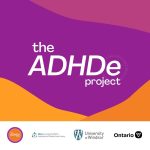
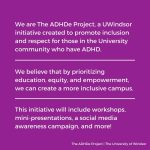
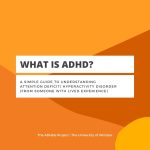

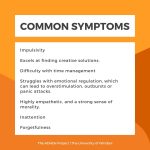
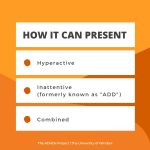
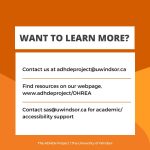
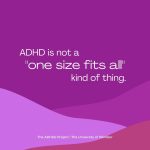
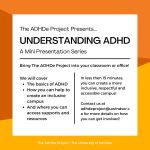
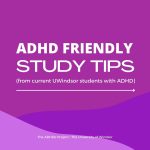
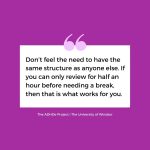
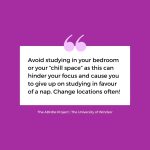
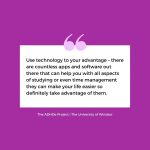
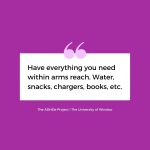
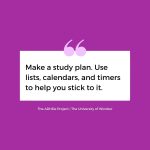
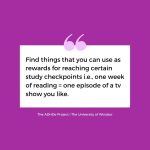
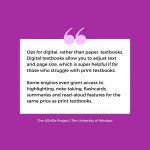
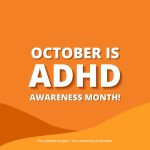
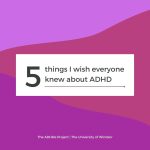
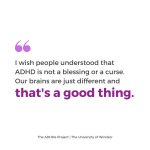
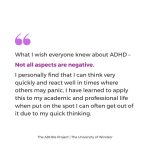
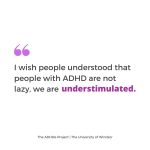
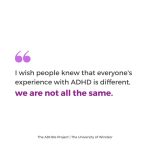
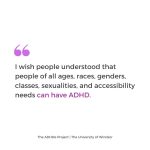
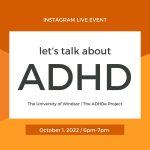
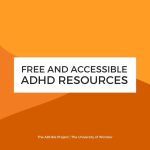

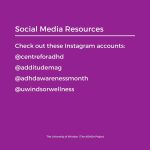
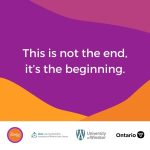
Captions
Post 1:
Hi! We’re The ADHDe Project! We know you’re busy and have a lot on your plate, but if you can give us approximately 45 seconds of your time we’d like to potentially change your life.
The ADHDe Project is a new University of Windsor initiative created to break down accessibility barriers on campus for people with ADHD and those who identify as neurodiverse.
We are…
- Student led (created and developed by a current student with ADHD)
- Built on the core beliefs of education, equity, and empowerment
- Ready to make the University experience amazing for ALL students
We will be offering…
- Free workshops
- Mini presentations
- ADHD resources and more
If you’re still reading it means we have gotten your attention. Here’s what comes next:
- Head to our website (search “the ADHDe project on the UWindsor website)
- Email us if you have any questions (adhdeproject@uwindsor.ca)
- Enjoy the rest of your scrolling! We’ll see you soon 😊
Post 2
“ADHD/ADD: a developmental disorder that is marked especially by persistent symptoms of inattention (such as distractibility, forgetfulness, or disorganization)” …. blah, blah, blah please someone tell me I’m not the only one who is tired of this “one size fits all” definition for ADHD.
So, lets switch it up a bit.
ADHD: a neurodevelopmental disorder. Symptoms can include distractibility, impulsivity, and hyper fixation. May also result in daydreaming, brilliant problem-solving skills, getting “a pleasure to have in class” written on your elementary school report card, and constantly bouncing your knee when seated.
Truth be told, ADHD isn’t just a list of symptoms. It’s not just a piece of paper with a diagnosis, and it’s definitely not a synonym for lazy, stupid, or unmotivated.
If any of this is resonating with you, swipe through all the slides on todays post to learn more ADHD and the resources that are available for neurodiverse students on campus.
Need some support, some motivation, or just someone to talk to?
We’re here (arrow down emoji)
Post 3:
Few quick questions…
- Do you ever feel overwhelmed or overstimulated, but you can’t figure out why?
- Did you have trouble maintain friendships when you were little?
- When you’re doing something you’re invested in, does three hours feel like three minutes?
Yes? Maybe a little bit?
Believe it or not, these are all lesser-known symptoms of ADHD.
We’ve been taught to believe that ADHD has one face; the face of a little hyperactive kid who won’t behave in school. Not only does this stereotype represent an extremely small portion of the ADHD community, but it also leads us to believe that every person with ADHD needs to fit into that mold.
I can guarantee you; it is not a “one size fits all” disability.
Folks with ADHD: Do you have any random symptoms that don’t fit the traditional definition of ADHD?
Post 4:
The ADHDe Project Presents…
Understanding ADHD, A Mini Presentation Series!
Bring The ADHDe Project into your classroom or office for a short presentation on ADHD and accessibility. We will cover
- The basics of ADHD
- How you can help to create an inclusive campus
- And where you can access supports and resources
In 15 minutes or less YOU can help to create a more inclusive campus!
Contact us at adhdeproject@uwindsor.ca to schedule your mini presentation.
Post 5:
Calling all students with ADHD (or anyone who needs some extra study tips), this post is for you!
With the beginning of a new semester, the inevitable midterm panic may be setting in for some of you. First things first, take a breath and relax your shoulders. You’re going to be ok; I promise. Here’s how:
- Start exam prep earlier than you think you need to
- Try a multi-sensory approach to studying
- Set timers and take breaks
Need some more ideas on how to conquer your midterm stress? Swipe through all the slides for some suggestions from current UWindsor students with ADHD!
Post 6:
Welcome to ADHD awareness month!
Every October, ADHDawarenessmonth.org celebrates people with ADHD and raises awareness through themed campaigns, workshops, and events. This year the theme is “Understanding A Shared Experience”.
In honour of ADHD awareness month, The ADHDe Project wants to acknowledge every person who has ADHD, regardless of diagnosis, gender, race, or religion. Although our brains may function in a similar way, we all experience our ADHD differently. Understanding how to support one another equitably while celebrating our individuality is important, and there’s no better time to start then now!
For more information on ADHD awareness month, head to adhdawarenessmonth.org.
Post 7:
We asked a group of current UWindsor students with lived experience what they wish everyone knew about ADHD.
Here’s what they had to say.
- I wish people understood that people with ADHD are not lazy, we are under stimulated.
- I wish people knew that everyone’s experience with ADHD is different, we are not all the same.
- I wish people understood that people of all ages, races, genders, classes, sexualities, and accessibility needs can have ADHD.
Swipe for more things we wish everyone knew about ADHD!
Post 8:
We’re going live! 🎉
The ADHDe Project will be hosting an open discussion on TBD, 2022, on Instagram Live.
This panel will be led by our project coordinators and will include a panel of students who will share their personal experiences with ADHD, as well as general awareness information.
Can’t wait to see you there!
Post 9:
To be honest, finding legitimate ADHD resources can be a pain. There’s a ton of info to search through, stuff is disorganized, and it’s rarely written in plain language.
You’d think that the people publishing the resources would have a better understanding of their target audience…
To make things easier, we’ve compiled a list of our favorite ADHD resources, that are also ADHD friendly.
Swipe through the slides for instructions on how to access the resource list (as well as some of our favourite Instagram resources) and let us know in the comments if you have any to add!
Post 10:
This is not the end, it’s the beginning.
The beginning and continuation of an important conversation.
The beginning of a more accessible campus.
The beginning of new connections and relationships that were built through this campaign.
The ADHDe Project would like to thank (insert page name here), as well as all of the other groups that have volunteered their platform over the last several weeks.
Be sure to check out our website, https://www.uwindsor.ca/ohrea/212/adhde-project, to learn more about our upcoming events!
Alt Text
Post 1:
- Slide 1: Simple graphic introducing a new ADHD awareness campaign. Background is purple and orange background with decorative abstract shapes. In the centre of the graphic, “the ADHDe project” is written in bold lettering. There are logo images for The ADHDe Project, The Learning Disability Association of Windsor Essex, The University of Windsor, and The Government of Ontario.
- Slide 2: Purple background with white text. Text reads “We are The ADHDe Project, a UWindsor initiative created to promote inclusion and respect for those in the University community who have ADHD. We believe that by prioritizing education, equity, and empowerment, we can create a more inclusive campus. This initiative will include workshops, mini presentations, a social media awareness campaign, and more!”.
Post 2:
- Slide 1: Yellow and orange infographic about ADHD. Text reads “What is ADHD? A simple guide to understanding attention deficit/ hyperactivity disorder (from someone with lived experience)”.
- Slide 2: What is ADHD? ADHD: A neurodevelopmental disability that affects a person’s ability to use executive function skills (such as time management, organization, emotional regulation, blah blah blah). Let’s paint a more accurate picture. ADHD: a neurodevelopmental disability. Symptoms can include distractibility, impulsivity, and hyper fixation. May also result in daydreaming, brilliant problem-solving skills and constantly bouncing your knee when seated.
- Slide 3: Common symptoms: excels at finding creative solutions, impulsivity, difficulty with time management, struggles with emotional regulation which can lead to overstimulation, outbursts, or panic attacks. Inattention, forgetfulness, highly empathetic and a strong sense of morality.
- Slide 4: Three types: Hyperactive, inattentive (formerly known as ADD), and combined.
- Slide 5: Want to learn more? Contact us at adhdeproject@uwindsor.ca. Find resources on our webpage, www.adhdeproject/OHREA. Contact sas@uwindsor.ca for academic/accessibility support.
Post 3:
- Purple graphic with decorative abstract shapes. White text reads “ADHD is not a one size fits all kind of thing”.
Post 4:
- Orange and yellow promotional graphic for mini-presentation series about ADHD and neurodiversity. Bolded text reads “Want to learn more about ADHD & Neurodiversity? Bring The ADHDe Project into your classroom or office for a mini presentation! We will cover the basics of ADHD, resources that are available, and how you can help to create an inclusive campus. Contact us at adhdeproject@uwindsor.ca for more details on how you can get involved!
Post 5:
- Slide 1: Purple infographic with ADHD friendly study tips written by current UWindsor students with ADHD.
- Slide 2: Don’t feel the need to have the same structure as anyone else. If you can only review for half an hour before needing a break, then that is what works for you.
- Slide 3: Avoid studying in your bedroom or your “chill space” as this can hinder your focus and cause you to give up on studying in favour of a nap. Change locations often!
- Slide 4: Use technology to your advantage – there are countless apps and software’s out there that can help you with all aspects of studying or even time management they can make your life easier so definitely take advantage of them.
- Slide 5: Have everything you need within arms reach. Water, snacks, chargers, books, etc.
- Slide 6: Make a study plan. Use lists, calendars, and timers to help you stick to it.
- Slide 7: Find things that you can use as rewards for reaching certain study checkpoints i.e., one week of reading = one episode of a tv show you like.
- Slide 8: Opt for digital, rather than paper, textbooks. Digital textbooks allow you to adjust text and page size, which is super helpful if for those who struggle with print textbooks. Some engines even grant access to highlighting, note-taking, flashcards, summaries and read-aloud features for the same price as print textbooks.
Post 6:
- Vibrant yellow and orange announcement post for ADHD awareness month. Bolded text reads “Welcome to ADHD Awareness Month!”.
Post 7:
- Slide 1: Simple purple graphic with a bold title. Text reads “5 things I wish everyone knew about ADHD”.
- Slide 2: I wish people understood that ADHD is not a blessing or a curse. Our brains are just different and that’s a good thing.
- Slide 3: What I wish everyone knew about ADHD – Not all aspects are negative. I personally find that I can think very quickly and react well in times where others may panic, I have learned to apply this to my academic and professional life when put on the spot I can often get out of it due to my quick thinking.
- Slide 4: I wish people understood that people with ADHD are not lazy, we’re under stimulated.
- Slide 5: I wish people knew that everyone’s experience with ADHD is different, we’re not all the same.
- Slide 6: I wish people understood that people of all ages, races, genders, classes, sexualities, and accessibility needs can have ADHD.
Post 8:
- Orange and white promotional post for an Instagram Live event, “lets actually talk about ADHD”. Collaboration between The University of Windsor and The ADHDe Project. Will take place on Instagram, date TBD.
Post 9:
- Slide 1: Title page for an ADHD resource guide. Text reads “Free and accessible ADHD resources”.
- Slide 2: How to access the document. Go to the University of Windsor homepage. In the search engine, search “The ADHDe Project”. Select the link to the “OHREA Initiatives”. Under the header “OHREA Initiatives”, select “The ADHDe Project”.
- Slide 3: Social media ADHD resources. @centreforadhd, @additudemag, @adhdawarenessmonth, @uwindsorwellness
Post 10:
- Wrap up post for The ADHDe Project social media campaign. A simple purple background with purple and orange abstract shapes. White text in the center of the graphic reads “This is not the end, it’s the beginning”. There are logo images for The ADHDe Project, The Learning Disability Association of Windsor Essex, The University of Windsor, and The Government of Ontario.

